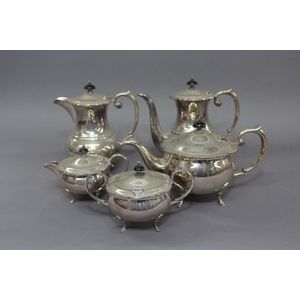Victorian Silver Tea Set with Engraved Presentation
You must be a subscriber, and be logged in to view price and dealer details.
Subscribe Now to view actual auction price for this item
When you subscribe, you have the option of setting the currency in which to display prices to $Au, $US, $NZ or Stg.
- Mahogany - Mahogany is a dense, close grained red-coloured timber from the West Indies and Central America. It was first imported into Europe in the the early 18th century and its use continued through the 19th century. It was popular for furniture making because of its strength, the wide boards available, the distinctive grain on some boards, termed flame mahogany and the rich warm colour of the timber when it was polished.. The "flame" was produced where a limb grew out from the trunk of the tree, and this timber was usually sliced into veneers for feature panels on doors, backs and cornices.
Some terms used to describe mahogany relate to the country from which it originally came, such as "Cuban" mahogany, "Honduras" mahogany etc. However unless the wood has been tested the names assigned are more a selling feature, rather than a true indication of the timber's origin. - Engraving - The method of decorating or creating inscriptions on silver and other metal objects by marking the surface with a sharp instrument such as a diamond point or rotating cutting wheel.
- Victorian Period - The Victorian period of furniture and decorative arts design covers the reign of Queen Victoria from 1837 to 1901. There was not one dominant style of furniture in the Victorian period. Designers used and modified many historical styles such as Gothic, Tudor, Elizabethan, English Rococo, Neoclassical and others, although use of some styles, such as English Rococo and Gothic tended to dominate the furniture manufacture of the period.
The Victorian period was preceded by the Regency and William IV periods, and followed by the Edwardian period, named for Edward VII (1841 ? 1910) who was King of the United Kingdom and the British Dominions and Emperor of India for the brief period from 1901 until his death in 1910. - Obverse - Obverse means the front face of a coin or medal, and the reverse means the back face. The obverse of a coin is commonly called heads, because it often depicts the head of a monarch or famous person.
This item has been included into following indexes:
- tea sets/services
Visually similar items

Antique pair Sheffield plate sugar bowl and jug, Old Sheffield Plate, panelled engraved decoration, gilt washed interior, each quad footed. Circa 1830. Height 14 cm (jug)

A good heavy Irish sterling silver three piece tea service 1837-9, of ornate eight lobed melon design with scroll handles and raised floral and rose decoration on four foliate feet. Dublin 1837 and 1839. Maker James Moore and Edward Murray., weight 1786g.

Angus & Coote Rundle silver plated five piece tea and coffee service (5)

Victorian sterling silver four piece tea and coffee service, London 1853, approx. 70 oz. troy
